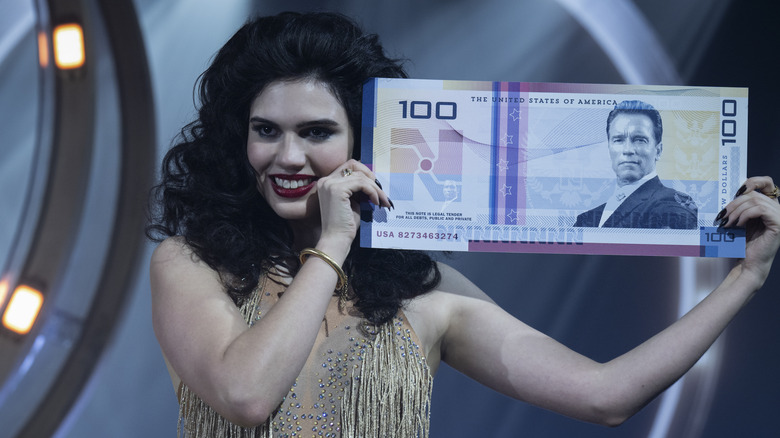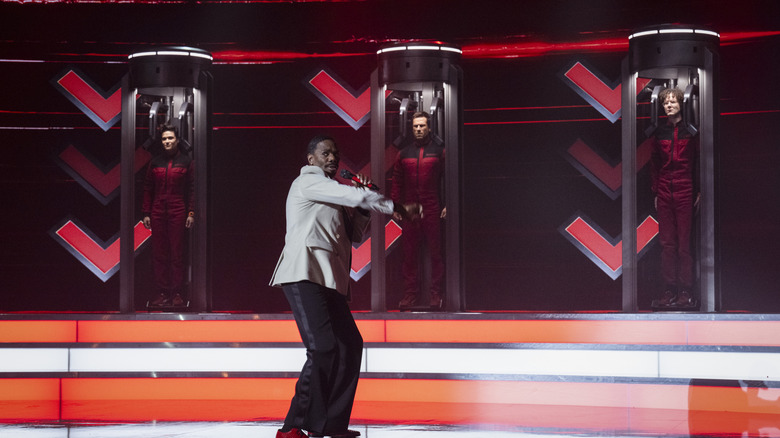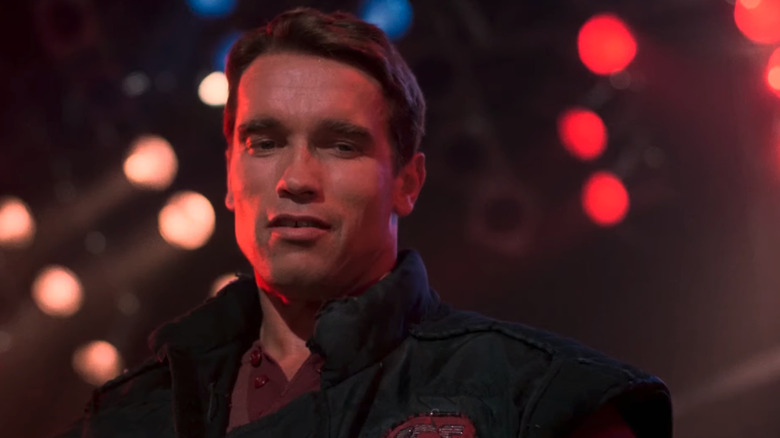The Running Man's Arnold Schwarzenegger 'Cameo' Isn't The Only Reference To The Original
If you've read Stephen King's "The Running Man," Edgar Wright's 2025 adaptation will feel a lot more familiar than the 1987 Arnold Schwarzenegger film. That's not a diss, it's a just a fact that the new version stays much closer to the beats of the novel. But while King's work is the guiding light, the film also takes plenty of opportunities to reference 1987's version of "The Running Man" specifically.
One of Schwarzenegger's best films, directed by Paul Michael Glaser and written by action legend Paul Michael Glaser ("Commando," "Die Hard"), the movie is far more campy and shows a different sort of dystopia from the new adaptation. Compared to the corporate fascism seen in Wright's version, the world is polluted, industrial, and more militant in its authoritarian regime. The "Running Man" game show itself is arguably the biggest divergence from King's book, however. The written version and Wright's film both show a reality show where the contestants are released into the regular world to be hunted down in part by ordinary citizens. The '87 movie turns this into more of a WWE cage match, with a cordoned-off, abandoned sector of decaying urban landscape set aside as the arena the runners must traverse.
While Schwarzenegger doesn't directly appear in the new "Running Man," he does make a quasi-cameo via the "New Dollars" future currency, whose bills bear the likeness of a smiling Schwarzenegger. This Easter egg featuring the original film's star is a nice touch, also making reference to the action star's career in politics. But it isn't the only time the 2025 movie pays homage.
The Running Man is full of 1987 Easter eggs
While the actual competitions in the two films are wildly different, the pomp and circumstance around them from the TV side are quite similar. The 1987 movie adorns its soundstage with big hair, "The Price is Right" audience segments, and extended dance sequences. Edgar Wright's version of "The Running Man" eschews some of the specifically '80s bits, but it keeps the bizarre cyber-cabaret stylings, with Colman Domingo's Bobby T. doing his best carny ringmaster impression. The dancer outfits and hairstyles also harken back more subtly to the distant future of 1987.
When the contestants are launched into the arena in the original film, they're sent in rocket sleds down winding tubes to the remains of the old city. This specific shot — one of the most iconic from the movie — is recreated in the new movie, with Ben Richards (Glen Powell) and the other runners loaded into tubs and jettisoned down from the soundstage to the basement floor. It's less roller coaster and more drop tower, if you want to get into the theme park semantics of it all, but it's a clear homage to one of the '87 film's most memorable moments.
There are other, less explicit references too. Michael Cera's water gun electrocution maneuver against a squad of Network goons evokes the way the electric stalker Dynamo meets his end in the original. In both films, Richards has a chance to finish off a defeated hunter, but he refuses on principle to kill a defenseless person. Of course, in both cases, the villain returns to insist upon their death.
The ending of The Running Man is more similar to the 1987 movie than the book
While Edgar Wright's "The Running Man" stays true to King's novel in most major beats, it diverges more substantially in the final act. In the book, Ben Richards pilots his hijacked jet directly into Dan Killian's office, killing them both. The ending of 2025's "The Running Man" is different and adds a bit more dimension, with the reveal that Ben actually ejects and survives, going on to be a major player in the armed resistance against the Network.
The final scene of the new film is more similar to the 1987 ending than it is to King's version. Both movies conclude with Ben storming the "Running Man" soundstage with a group of armed militants and exacting violent vengeance on Killian in person. While it would have been interesting to see some more of the actual mechanics behind the scenes in the new movie (How long was this brewing? How did Ben get connected with the resistance?), Wright plays fast and loose with the finale, leaving the viewer to fill in the gaps.
Though it can hardly be called a political treatise, the original film at least provides some background for the armed insurrection that Ben ultimately becomes a part of. Regardless, if you've seen the Schwarzenegger movie, it's sure to come to mind in the final moments of Wright's "The Running Man."


